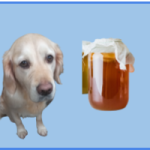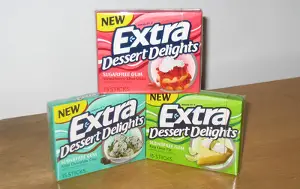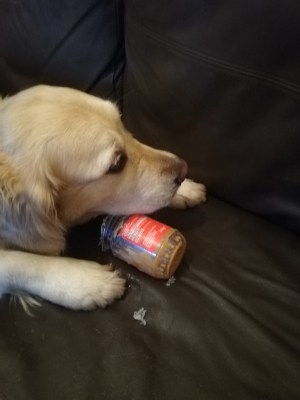
Peanut butter, if used in the right way, can be an amazing treat for dogs- and their owners too!
It is a well known trick to hide pills in and used extensively in interactive toys, such as Kongs.
Plus, washing out an “empty” peanut butter jar ready for recycling is a real chore.
Giving it to your dog to “pre wash” makes that job far easier.
But peanut butter isn’t all a bed of roses.
There are two immediate dangers with peanut butter.
Giving our dogs too much peanut butter is an easy mistake to make and bad for our dogs.
And giving our dogs the wrong sort of peanut butter could kill them.
What is the nutrition in peanut butter?
A quick look at the nutrition of four different pots of peanut butter is shown below.
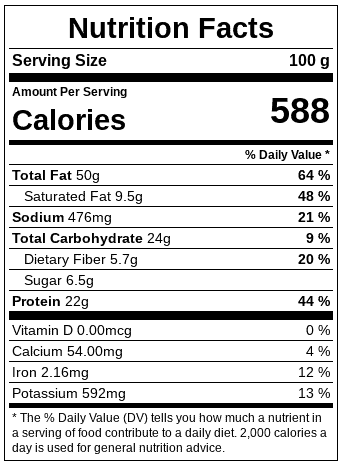
And those varieties are; standard, low sugar, lower sodium and reduced fat.
| 100g serving | Standard | Low sugar | Lower Sodium | Reduced fat |
| Calories | 598 | 650 | 598 | 520 |
| Fat | 50% | 55% | 51% | 34% |
| Sodium | 476 mg | 292 mg | 17 mg | 540 mg |
| Carbohydrate | 24% | 14 % | 22 % | 36% |
| Fibre | 6% | 7.8% | 5 % | 5.2% |
| Sugar | 6.5% | 6.4 % | 10% | 9.3 |
| Protein | 22% | 25% | 22 % | 26% |
Now, regardless of which way that you look at it, peanut butter is very high in everything.
The lowest amount of calories for a 100 g serving is 520 and the highest is 650 in the low sugar variety.
Oh, the irony!
Because it is high in calories, it is very high in fat.
The low sugar variety is 55% whereas the reduced fat pot of peanut butter is only 34%.
Now, peanut butter is often highlighted as a high fat food that contains good fat.
This is because, among other things, it is high (around 20%) in monounsaturated fats, a fat that is contained in food such as olive oil and avocados.
A surprise to many of you might be how much sodium (salt) there is in peanut butter.
A reduced fat pot contains the most at 540 mg which is 23% of a human’s recommended daily allowance, let alone a dog’s!
Not surprisingly the lowest comes in the reduced sodium addition and this contains a mere 17 mg.
But what the reduced sodium lacks in sodium it makes up for in sugar, where at 10% it contains the most.
The carbohydrate numbers are again very high.
The reduced fat is 36% carbs whereas the low sugar variety is only 14%.
But watch out because low sugar peanut butter has the most calories in it.
The lower sodium and reduced fat have the highest amounts of sugar in them at 10% and 9.3% respectively.
What are the side effects of eating peanut butter?
The best side effect of eating peanut butter as far as your dog is concerned is licking their lips, trying to make that great taste linger as long as possible in their mouths!
However, other side effects aren’t so great.
Eating too much food with such a high fat content as peanut butter could be dangerous to your dog.
Obesity
No surprise here, is there?
High fat foods can cause dogs to become overweight.
A report in 2019 showed that 55.8% of dogs in the US are overweight or obese.
No, it is important to say that obesity isn’t just caused by dogs eating fatty foods.
There are lots of other factors involved as well- the amount of exercise that a dog gets is one such factor.
Pancreatitis
The pancreas is a small organ in the stomach which releases chemicals which help in digesting food.
It also releases insulin to control blood sugar levels.
Pancreatitis occurs when this organ becomes inflamed..
There are a few things that might causes of pancreatitis- being obese is one of them but having a diet that is high in fat is another.
Signs to look out for in your dog including inertia, vomiting, diarrhea and having a sore abdomen.
So having looked at some of the unpleasant side effects of eating too much peanut butter, I want to now look at whether peanut butter can kill your dog- and in what circumstances.
What is xylitol and why is it dangerous to dogs?
There are two ways in which peanut butter can kill your dog- fast and slow.
In this section I will focus on the fastest way to kill your dog and in the next section I will focus on the slow way.
The fastest way to kill your dog is to feed them a sugar-free brand of peanut butter that contains xylitol.
Xylitol is used to replace sugar in sugar free or low sugar products.
It is as sweet as sugar but contains about 40% of the calories.
Which is perhaps a great news for people but it is bad news for dogs.
Xylitol is poisonous for dogs because their bodies cannot process it.
Instead of it being harmlessly absorbed into a dog’s bloodstream, Xylitol tricks the body into releasing lots of insulin.
This in turn causes a dog’s blood sugar level to nosedive, which if it isn’t treated immediately can be life-threatening.
The symptoms to look out for aren’t pleasant but they are obvious.
They include your dog vomiting and moving as if they are drunk.
You might also see some seizures or tremors.
There is really only one way to treat this which is to get your dog to the vet as fast as is feasibly possible.
How much xylitol can kill a dog?
If your dog has ingested more than 75 mg of xylitol for every kg that they weigh then not only will they need to go to the vets but the vets will need to keep them in for observation.
The trouble is that nobody knows exactly how much xylitol is used in low sugar versions of peanut butter.
Later on in this article I will provide a list of dog safe brands of peanut butter- these are brands of peanut butter that don’t contain any xylitol.
But the safest thing that you can do as a dog owner is to avoid buying any variety of low sugar peanut butter.
We saw when we were looking at the nutrition charts earlier that low sugar varieties of peanut butter I’m not really a very healthy alternative.
Unless you are a peanut loving diabetic, of course.
To put the potency of xylitol into some kind of context it is many times more toxic for your dog than even dark chocolate- which is dangerous enough.
Having dealt with the fast ways that peanut butter that contains xylitol will quickly kill your dog, I want to move on and the slow ways.
How much peanut butter can kill a dog?
The slow way to kill your dog with peanut butter is to give your dog too much to eat.
Now it is highly unlikely that you will kill your dog with a one off mega dose of peanut butter.
What is far more likely is that your dog is being fed too much peanut butter everyday over months and this leads to weight gains or even obesity.
I’m a one-stop-shop for good news in this article aren’t I?!
But the great thing is that the slow way of killing your dog can easily be stopped.
Peanut butter is considered a treat when you are feeding it to your dog.
And the rule of thumb when giving your dogs a treat is that they should not total more than 10% of their daily intake of calories.
And when you look at peanut butter in that light it can become a bit scary because it is so high in calories.
We know from earlier that the average calorie count 100g of peanut butter was somewhere around 550.
100g of peanut butter is just over 4 tablespoons.
This isn’t a lot when you start thinking about how much you might put in a Kong puzzle.
Let me give you an example.
This calculator recommends that one of my golden retrievers (who weighs 30 kg) should be eating 1615 kilocalories a day.
Two tablespoons of peanut butter is about 1/6 of her daily calorie allowance.
Or to put it even more bluntly, if I was to restrict the amount of peanut butter to a tenth of her daily calorie allowance, it would mean that she could eat just over one-and-a-half tablespoons.
If you want to feed your dog peanut butter, feed them little amounts and not very often- keep it as a treat to have once a week or even once every two weeks.
Can dogs eat peanut butter cookies?
Whilst there aren’t any toxic ingredients in a peanut butter cookie that could poison your dog, neither do they resemble a healthy snack in any way.
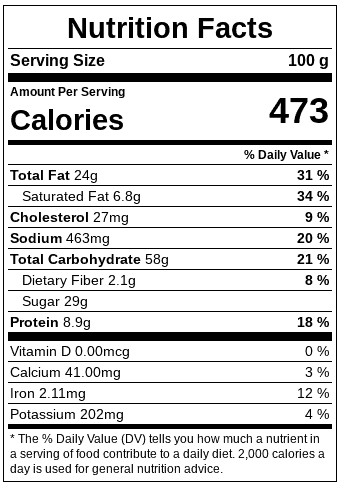
But you can see for yourself by looking at the nutrition data for one of these cookies on your right.
But I have to stifle a little giggle here because for the same size serving, peanut butter cookies have fewer calories than peanut butter!
However, whereas butter butter is high in fat and lower in carbs, peanut butter cookies are lower in (fat 24% vs 50%) and higher in carbs (58% vs 20%.)
And most of the carbs in the cookie are sugar- about 29%.
Not only can too much sugar cause dogs to become overweight, it will also wreak havoc with their teeth.
Yes, dogs can have a bite of a peanut butter cookie.
Should they? Probably not.
Can dogs eat peanut butter crackers?
I would have thought that in a toss up between cookies and crackers, then crackers would have been, by far, the healthier option.
But a quick look at the nutrition has changed my mind.
These crackers are loaded with salt. A 100 g serving providing around 25% of a human’s recommended daily intake of salt.
Combined with the high amount of sodium that is already in peanut butter, I would recommend that you just feed your dogs small amounts of peanut butter.
Skip the crackers and if necessary let them lick some straight from the spoon!
What are dog safe peanut butter brands?
The great news is that some of the most popular and biggest selling brands of peanut butter are safe for your dog.
These include: Jif, Skippy, SunButter and Smuckers.
Also more “natural” peanut butters will also be xylitol free.
These are peanut butters that use a much higher percentage of peanuts, sometimes 100%- like Crazy Richard’s All Natural Peanut Butter.


